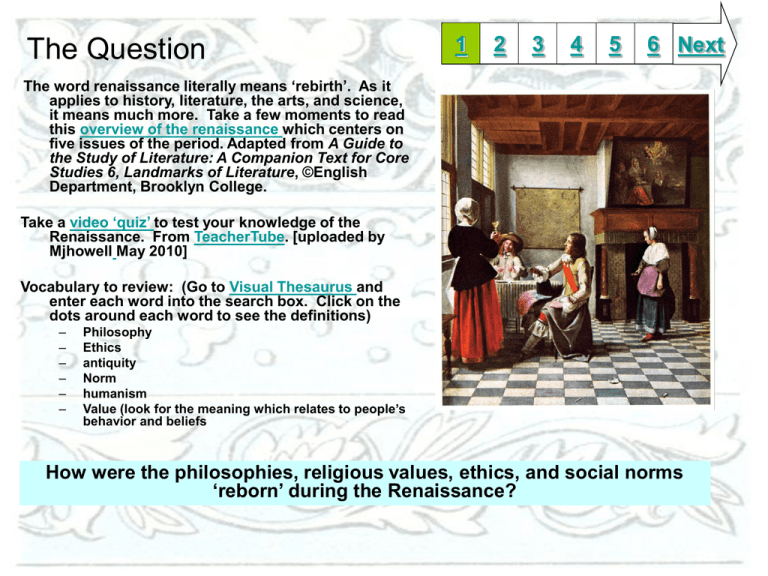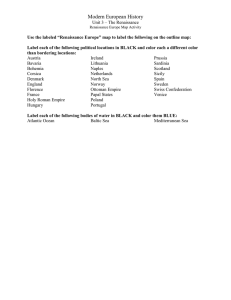
The Question
1
2
3
4
5
6 Next
The word renaissance literally means ‘rebirth’. As it
applies to history, literature, the arts, and science,
it means much more. Take a few moments to read
this overview of the renaissance which centers on
five issues of the period. Adapted from A Guide to
the Study of Literature: A Companion Text for Core
Studies 6, Landmarks of Literature, ©English
Department, Brooklyn College.
Take a video ‘quiz’ to test your knowledge of the
Renaissance. From TeacherTube. [uploaded by
Mjhowell May 2010]
Vocabulary to review: (Go to Visual Thesaurus and
enter each word into the search box. Click on the
dots around each word to see the definitions)
–
–
–
–
–
–
Philosophy
Ethics
antiquity
Norm
humanism
Value (look for the meaning which relates to people’s
behavior and beliefs
How were the philosophies, religious values, ethics, and social norms
‘reborn’ during the Renaissance?
Information Sources
1
2
3
4
5
6 Next
You will use the following resources to search for meaning and
information on the renaissance.
– Social Background
– Background of Ideas
– Interactive Renaissance
– Life in Elizabethan England
As you research, consider these questions:
• How did the Plague alter the feudal economic system?
• How did the changes in economics and politics alter the social and
ethical values of the people?
• How did the idea of humanism arise?
• Why did people want to study the classical world (e.g.Rome and
Greece)?
• How did the change in personal values alter religious views?
From your introductory reading and vocabulary exploration, develop 23 questions of your own.
The Student Activity
1
2
3
4
5
6 Next
You will work in groups to research one aspect
of the Renaissance and how it was different
from the Middle Ages.
•
Philosophy/Ideas
•
Religion
•
Ethics
•
Social norms
•
Scientific exploration
•
Intellectual and Artistic pursuits
Use this graphic organizer to take notes.
Each group will create an Animoto animation
which reflects their findings. For your
animation you will need images, text,
sounds, and any other multimedia items
which help depict your findings Review the
step-by-step directions.
As an alternative, your teacher may ask you to
create a PowerPoint with the same types of
items. Your PowerPoint should include a
minimum of five slides.
Choose carefully! Your items should reflect your
findings!
Your group will present your product on the
second day, comparing the Renaissance
views to those of the Middle Ages.
Photo White Tower, Tower of London, B. Falkinburg Aug. 2006
The Assessment Activity
1
2
3
4
5
6 Next
Make sure you check the Animoto scoring tool to ensure
you will meet all of the criteria. If your teacher asks you
to use PowerPoint, check the scoring tool for your
presentation.
Your group will present your finished product showing how
the topic you researched changed with the Renaissance.
Photo, Queen’s Apartments, Tower of London B. Falkinburg, Aug 2006
Extension/Enrichment
Activities
1
2
3
4
5
6 Next
As you begin to look at the literature of
Renaissance, check out these websites
which will help you focus on the life and
literature of the time period.
The Sixteenth Century – companion website for
the Norton Anthology of Literature
The Renaissance Connection – interactive
website from the Allentown Museum.
Now that you have examined all the resources,
created your presentation, and watched the
other group presentations, check out the
definition of a Renaissance Man.
Photo, King Henry VIII suit of Armor, Tower of London,
B. Falkinburg, Aug 2006
Think about the people you know. Who do you
know that you would consider a
‘Renaissance Man (or Woman)’? Explain
why in a short reflection. Remember to use
examples from your study of the time
period. (Your teacher might assign this for
homework.)
Teacher Support Materials
Lesson Objective:
The student will prepare for reading Renaissance literature by
researching background information on the Renaissance.
1
•
•
•
•
1.1.1 The student will prepare for reading, viewing, and/or listening to
a text.
- Research background information as a preparation for reading.
3.1.5: The student will create effective media presentations that use
visuals and/or sound and appropriate technology to present a
particular point of view on a topic or idea
5.1.2 The student will participate in and contribute to large- and
small-group collaboration for a variety of assigned and self-selected
purposes
5.2.3 The student will use appropriate props, visual aids, and
electronic media to enhance accuracy and audience appeal
6.1.2 The student will demonstrate understanding of information and
ideas communicated orally
AASL Standards for the 21st Century Learner:
•
1.1.6 Read, view, and listen for information presented in any format
(e.g., textual, visual, media, digital) in order to make inferences and
gather meaning.
•
2.1.6 Use the writing process, media and visual literacy, and
technology skills to create products that express new understandings
•
3.1.1 Conclude an inquiry- based research process by sharing new
understandings and reflecting on the learning.
•
3.1.3 Use writing and speaking skills to communicate new
understandings effectively
•
3.1.4 Use technology and other information tools to organize and
display knowledge and understanding in ways that others can view,
use, and assess
3
4
5
6
ISTE NETS for Students:
•
Students demonstrate creative thinking, construct knowledge,
and develop innovative products and processes using
technology.
•
Students use digital media and environments to communicate
and work collaboratively, including at a distance, to support
individual learning and contribute to the learning of others
•
Students demonstrate a sound understanding of technology
concepts, systems, and operations.
MSC Standards for English:
•
2
Time Management:
•
The lesson should take two days. The first day is for research
and creation of product. Day two is for sharing of the products
and completing the reflection. The reflection could be
assigned for homework.
Differentiation Strategies:
•
Group/partner students heterogeneously by reading ability and
technology skills
•
Have students use assistive tools embedded in the BCPS
databases such as read aloud and dictionary links.
Learning Preferences/Styles:
•
Field dependent, auditory, visual, active, reflective, global,
sequential, kinesthetic
Notes to the Teacher:
•
•
Animoto does require registration. You might want to ask
students to register ahead of time . There is a guide which
could also be printed a head of time. It is recommended that
you also print copies of graphic organizer ahead of time. The
Enrichment/Extension activities could be included for
homework or other extra credit assignment.
Consult with your Library Media Specialist for help in
implementing the Slam Dunk.
Created by Barb Falkinburg, Library Media Specialist, Updated July 2015
BCPS Slam Dunk Model, Copyright 2010 , Baltimore County Public Schools, MD, all rights reserved. The models may be used for educational, non-profit
school use only. All other uses, transmissions, and duplications are prohibited unless permission is granted expressly. This lesson is based on Dr. Jamie
McKenzie’s Slam Dunk Lesson module.

